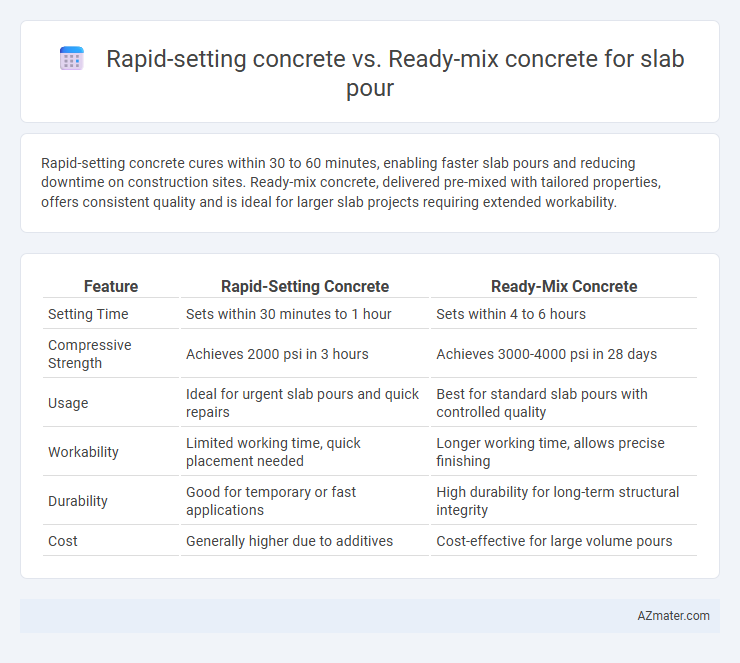Rapid-setting concrete cures within 30 to 60 minutes, enabling faster slab pours and reducing downtime on construction sites. Ready-mix concrete, delivered pre-mixed with tailored properties, offers consistent quality and is ideal for larger slab projects requiring extended workability.
Table of Comparison
| Feature | Rapid-Setting Concrete | Ready-Mix Concrete |
|---|---|---|
| Setting Time | Sets within 30 minutes to 1 hour | Sets within 4 to 6 hours |
| Compressive Strength | Achieves 2000 psi in 3 hours | Achieves 3000-4000 psi in 28 days |
| Usage | Ideal for urgent slab pours and quick repairs | Best for standard slab pours with controlled quality |
| Workability | Limited working time, quick placement needed | Longer working time, allows precise finishing |
| Durability | Good for temporary or fast applications | High durability for long-term structural integrity |
| Cost | Generally higher due to additives | Cost-effective for large volume pours |
Introduction to Slab Pouring Methods
Rapid-setting concrete offers accelerated curing times, making it ideal for slab pours requiring reduced downtime and faster project completion. Ready-mix concrete provides consistent quality and precise mix proportions delivered directly to the site, ensuring uniform slab strength and durability. Choosing between these depends on project timelines, structural requirements, and environmental conditions influencing slab performance.
What is Rapid-Setting Concrete?
Rapid-setting concrete is a fast-curing cementitious material designed to achieve high early strength within hours, making it ideal for slab pours requiring minimal downtime. It utilizes additives like calcium chloride or specialized polymers to accelerate hydration, allowing construction schedules to stay on track and reducing waiting time before formwork removal or subsequent finishes. This type of concrete contrasts with traditional ready-mix concrete, which typically takes 24 to 48 hours to reach comparable strength levels for slab applications.
Understanding Ready-Mix Concrete
Ready-mix concrete is a pre-mixed, factory-produced material designed for consistent quality and precise composition, ideal for slab pours requiring uniform strength and smooth finish. It offers time efficiency and reduced labor costs by delivering concrete tailored to project specifications, minimizing onsite mixing errors and variability. Compared to rapid-setting concrete, ready-mix concrete provides better workability and longer setting times, allowing for proper placement and finishing in large slab applications.
Key Differences: Rapid-Setting vs Ready-Mix
Rapid-setting concrete achieves high early strength within hours, enabling faster slab pours and reduced downtime, while ready-mix concrete offers consistent quality and workability suited for larger projects with longer curing times. Rapid-setting formulas typically contain accelerators and specialized cementitious materials that harden quickly, whereas ready-mix concrete relies on standard Portland cement with controlled batching and mixing processes. Cost considerations for rapid-setting concrete are higher due to additives, but its time-saving benefits make it ideal for urgent repairs, contrasting with the economical and versatile nature of ready-mix concrete for general construction slabs.
Strength and Durability Comparison
Rapid-setting concrete achieves high early strength, often reaching 3,000 psi within 24 hours, making it ideal for projects requiring quick turnaround times. Ready-mix concrete typically gains strength more gradually, reaching standard compressive strengths of 4,000 to 5,000 psi over 28 days, which enhances long-term durability for slab pours. While rapid-setting concrete provides sufficient early strength, ready-mix concrete's controlled mix design yields superior durability and resistance to cracking and environmental wear.
Setting Time and Construction Schedule
Rapid-setting concrete typically achieves initial set within 30 minutes to 2 hours, enabling faster slab pours and significantly reducing construction downtime compared to ready-mix concrete, which generally sets in 4 to 6 hours. The accelerated setting time of rapid-setting concrete allows construction schedules to advance with minimal delay, making it ideal for projects with tight deadlines or cold weather conditions. Ready-mix concrete offers consistent quality and ease of use but may extend project timelines due to longer curing requirements before load application.
Cost Implications and Budget Considerations
Rapid-setting concrete typically incurs higher upfront costs compared to ready-mix concrete due to specialized additives and expedited production processes. Ready-mix concrete offers more cost-effective scalability for large slab pours, minimizing labor expenses through consistent batching and reduced on-site preparation time. Budget considerations should weigh the premium on rapid-setting concrete for time-sensitive projects against potential savings from the extended setting times and logistical efficiencies of ready-mix concrete.
Application Suitability: When to Choose Each
Rapid-setting concrete is ideal for slab pours requiring fast turnaround times, such as emergency repairs or cold weather conditions where early strength gain is critical. Ready-mix concrete suits large-scale slab projects with extended working times and consistent quality, enabling smooth placement and finishing over expansive areas. Choose rapid-setting concrete for time-sensitive applications and ready-mix concrete for scheduled pours demanding uniformity and volume control.
Environmental Impact and Sustainability
Rapid-setting concrete reduces construction time and often requires less energy for curing, minimizing carbon emissions during the slab pour process. Ready-mix concrete typically involves centralized batching plants that optimize material use and reduce on-site waste, contributing to sustainability by lowering overall resource consumption. Choosing rapid-setting concrete can further decrease environmental impact by enabling faster project completion and reducing the need for prolonged equipment operation.
Final Recommendations for Slab Projects
Rapid-setting concrete is ideal for slab projects requiring expedited strength gain and early load-bearing capacity, significantly reducing downtime and enabling faster construction schedules. Ready-mix concrete offers consistent quality and is best suited for larger slab pours where extended working time and uniform curing are essential to achieve optimal structural integrity. For slab projects prioritizing speed and quick turnaround, rapid-setting concrete is recommended, whereas ready-mix concrete is preferable for standard or complex slab pours demanding controlled placement and finishing.

Infographic: Rapid-setting concrete vs Ready-mix concrete for Slab pour
 azmater.com
azmater.com